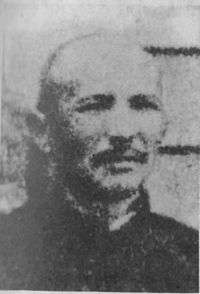Sun Dianying

Sun Dianying (Traditional Chinese: 孫殿英; Simplified Chinese: 孙殿英; pinyin: Sūn Diànyīng; Wade-Giles: Sun Tienying; 1889–1948) was one of the minor warlords during the Warlord Era.
Biography
Born in 1889 in Yongcheng, Henan, Sun was originally a bandit in the area of Henan Anhui. He gradually extended his influence and power through years. In 1925 Sun joined the National Revolutionary Army. In 1928, he plotted the notorious looting of the Eastern Mausoleum of the Manchu emperors. The tombs desecrated included that of the late Empress Dowager Cixi. Later, with Feng Yuxiang and Yan Xishan, Sun participated in various anti-Chiang Kai-shek movements. In Jehol-Chahar Sun Dianying's army included the writer Duanmu Hongliang.[1]
In 1932-33, when the Japanese forces of the IJA 4th Cavalry and 6th Division in Operation Nekka invaded Jehol/Rehe he commanded the 41st Army in effective opposition to the Japanese in the Battle of Rehe. This slightly rehabilitated his reputation, but he also seized the chance to expand his strength. At the time of the Tanggu Truce, Sun's troops garrisoned the strategic Peiking Suiyuan railroad.
In May 1933, with Feng Yuxiang in Chahar province organizing the Chahar People's Anti-Japanese Army, Sun too advocated opposition to Japan and criticised Chiang Kai-shek's Central government, yet protested his loyalty to Chiang. The national government feared Sun Dianying would cooperate with Feng's Anti-Japanese Army, allowing them to use the railroad to support their forces. However Sun was also not willing to be involved in a conflict with Chiang. He hoped to be involved in northwest development and control a territory of his own there. In mid June, when Chiang ordered Sun's army to leave the railroad garrison and open up wasteland in Qinghai he was willing to go. Chiang's troops replaced them in July, cutting off the Anti-Japanese Army from communication with the rest of China.
Chiang intended the allied northwest Ma clique would have the strength to cope with Sun Dianying and be weakened themselves. Additionally Chiang sent Zhu Shaoliang to the northwest as Gansu Pacification Director, who for his own benefit, secretly encouraged the three Ma Sultanates to block and prevent Sun from entering his new post. Strong protests from the region, and Chiang's weakness in the area eventually persuaded him to halt Sun's advance through Suiyuan province in November 1933. However his forces became short of food and restive from their inactivity.
In January 1934 with his army threatened with starvation and mutiny, Sun Dianying was forced to march his 60,000 man army west from Suiyuan province into Ningxia, governed by Ma Hongbin. Supported by his fellow Ma Clique warlords Ma Hongkui in Gansu, and Ma Bufang with his younger brother Ma Buqing in Qinghai, Ma Hungpin refused and with the united Ma forces began the Four Ma Jusun Campaign. Both sides battled for three months, with heavy loss to both sides. At last in March Yan Xishan dispatched troops into the battle cutting Sun's avenue of retreat, while Chiang Kai-Shek seized the chance to publicly abolish Sun's various duties. Sun Dianying was compelled to retreat back to Baotou in the beginning of April, and then went to Taiyuan to live in seclusion, the remnants of his defeated troops were incorporated by Yan Xishan into his provincial forces.
In 1937, when the Second Sino-Japanese War erupted, Sun resurfaced once again commanding troops against the Japanese, taking command of the Hebei-Chahar Guerillas in 1938. In 1943 he became the General commanding 5th Army. However he surrendered to the Japanese soon after and joined Wang Jingwei's collaborationist Nanjing Nationalist Government, given command of 24th Army Group and the 6th Front Army, also a member of its National Military Council. In August 1943 his command was defeated by PLA forces in the Linnan Campaign.
When the Second Sino-Japanese War was over, Sun participated in the Chinese Civil War on Nationalist's side. In 1947, he was defeated by People's Liberation Army and was taken prisoner. In October 1948, he died in the POW camp of Wu'an.
See also
References
- ↑ Joseph S. M. Lau; Chih-tsing Hsia; Leo Ou-fan Lee (January 1981). Modern Chinese Stories and Novellas, 1919-1949. Columbia University Press. pp. 484–. ISBN 978-0-231-04203-1.
Sources
- 民国军阀派系谈 (The Republic of China warlord cliques)
- 中国抗日战争正面战场作战记 (China's Anti-Japanese War Combat Operations)
- Author : Guo Rugui, editor-in-chief Huang Yuzhang
- Jiangsu People's Publishing House
- Date published: 2005-7-1
- ISBN 7-214-03034-9
- China and Eurasia Forum Quarterly, Volume 5, No. 1; Nationalists, Muslim Warlords, and the “Great Northwestern Development” in Pre-Communist China by Hsiao-ting Lin, p. 121-142 (2007)